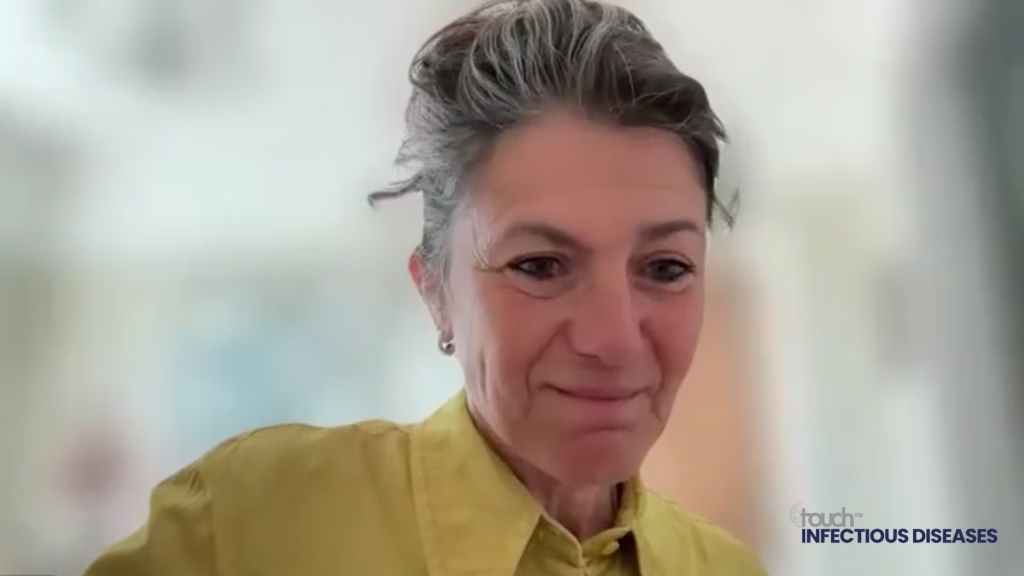touchINFECTIOUSDISEASES caught up with Dr Monica Gandhi (University of California, San Francisco, CA, USA) about the recent advances in HIV treatment strategies for naïve or suppressed patients, and patients with resistance. Dr Gandhi also touched on the latest advances in terms of long-acting antiretroviral therapy, and summarized the key take-home messages of her presentation.
The presentation, ‘Advances in HIV Treatment Strategies‘, was presented at the Conference on Retroviruses and Opportunistic Infections (CROI) 2023, 19–22 February 2023.
Questions:
- What have been the most important recent advances in HIV treatment strategies in naïve or suppressed patients? (0:17)
- What have been the most important recent advances in HIV treatment strategies in patients with resistance? (2:16)
- What new treatment strategies are being explored for long-acting antiretroviral therapy? (4:28)
- What are the key take-home messages from this presentation? (6:41)
Disclosures: Monica Gandhi has received grant/research support from the NIH.
Support: Interview and filming supported by Touch Medical Media Ltd. Interview conducted by Atiya Henry.
Filmed as a highlight of CROI 2023.
Transcript:
What have been the most important recent advances in HIV treatment strategies in naïve or suppressed patients? (0:17)
My name is Dr Monica Gandhi. I’m a professor of medicine and infectious disease doctor at UCSF (University of California, San Francisco, CA, USA), and I also direct the Ward 86 HIV clinic at UCSF.
In naïve and suppressed patients, we don’t want to sit still with that. And what I mean is that HIV medicine is always changing. So, you know, earlier on in development, the non-nucleoside reverse transcriptase inhibitors and protease inhibitors were the anchor drugs that we used. In 2008, the first integrase inhibitor came out, which is raltegravir, and it just got better from there. Essentially, all of these integrase inhibitors that we have – we have now five, if you include the long-acting integrase inhibitor – are first-line therapy. But the reason not to sit still with that is to think about, though these drugs are great, what are our limitations of these medications? What do we still need to learn about them and what do we need to mitigate some of their impact? What is really coming out in naïve and suppressed patients is that there is this issue of weight gain that is not benign, that can be quite substantial. There was a large study from the Swiss HIV cohort study that didn’t show that the starting of integrase inhibitors was associated with cardiovascular events, which is a very important abstract for this meeting. So if it’s weight without clinical consequences yet, then what do we do to control that weight? Do we pair integrase inhibitors with some of our older NRTIs, like TDF? Do we think about NNRTIs in selected cases which are not associated with weight changes at all, if our weight gain is too much? It is called the art of medicine, and that is really what we need to be doing with our naïve and suppressed patients, not thinking of them as a swath of patients, but thinking about individualized care if there are complications of the integrase inhibitor therapies. So I think that’s where we are, knowing that the long-acting and maybe some of these non-integrase inhibitor based classes could be associated with fewer side effects.
What have been the most important recent advances in HIV treatment strategies in patients with resistance? (2:16)
In terms of resistance, it’s a really, really good question because a question was asked of me at the podium when I gave this talk, about what are our options in low- and middle-income countries and what are the options in high-income countries? Because there is actually a difference. The medications that we use for highly resistant patients are really quite specialized. There’s an attachment inhibitor called fostemsavir, there’s an entry inhibitor called ibalizumab, there’s a CCR5 receptor antagonist called maraviroc, and now there’s been approval of the first in kind capsid inhibitor called lenacapavir, for multidrug-resistant patients living with HIV. Those are all really only available in high-income settings. And so what we use in low- and middle-income settings are still our protease inhibitors, because the protease inhibitor class has a very low rate of mutations worldwide. And darunavir as a protease inhibitor could still be used for patients with integrase inhibitor mutations and other mutations in low- and middle-income countries. Then there was a very interesting study from Zimbabwe about fostemsavir resistance, meaning that fostemsavir, this oral attachment inhibitor, is coming to low- and middle-income countries. It is an orally available drug. It is something that I think we’re going to get and it’s going to be made more available. And so, we have to remember that we shouldn’t ever, like often happens, divide the world into two places where there are medications available for high-income countries and those available for low- and middle-income countries. This has come up a lot when we’re thinking about cabotegravir and rilpivirine. It is not yet endorsed as a HIV treatment strategy by the World Health Organization, though it’s endorsed in US guidelines, UK guidelines, European guidelines, because it hasn’t yet been made inexpensive enough to become a worldwide treatment. That global equity and that discussion has come up often at CROI.
What new treatment strategies are being explored for long-acting antiretroviral therapy? (4:28)
So the long-acting is interesting. This was the final section of the talk and I divided that into two categories. One is long-acting cabotegravir and rilpivirine – we already knew about the trials that led to its approval, which were the FLAIR ATLAS and ATLAS-2M trials. Those were sort of two years ago news, and that’s why these drugs have been approved. What has been coming out is novel ways to use long-acting cabotegravir and rilpivirine. I presented data at this meeting yesterday from Ward 86, the HIV clinic that I serve as a medical director, where we have been trying to use long-acting cabotegravir and rilpivirine, not in the way it was used in the clinical trials, which was only in virologically suppressed patients who were on oral antiretroviral therapy. We have been trying to use it in patients with viremia, in patients who could not take the oral therapy, could not get suppressed, and yet need this medication because they have adherence challenges to taking oral ART. That data was presented yesterday, and I think it was thought provoking and there are a lot of other centres who are starting to use long-actings in viremic patients. Second major strategy will actually be presented at CROI this Wednesday morning. This is essentially data on lenacapavir with two broadly neutralizing antibodies in a small patient population, just one dose every six months, keeping those patients suppressed. And then finally, lenacapavir has two major studies that are still ongoing. One is the CAPELLA study, which led to its approval in multidrug-resistant patients with HIV. That CAPELLA study – there are some data presented at this meeting about the mutations in the CAPELLA studies. So we’re now starting to define which mutations confer resistance to lenacapavir. The second major study being presented at CROI is the CALIBRATE study. This is lenacapavir with oral agent in naïve patients and the 80-week data has been presented at this meeting showing that it’s looking pretty good for naïve patients, in a small study population. There’s not yet treatment indication in naïve patients because it’s such a small study.
What are the key take-home messages from this presentation? (6:41)
I think the key take-home message is that we are in an incredible time to treat HIV medicine. We have many options across multiple parts of the HIV viral lifecycle. It is now becoming an art to treat HIV medicine. Think of every patient individually. We have large recommendations that go across sets of populations, but each patient that’s sitting in front of you is an individual. And if they are having side effects on one of the medications, we have enough options to think about other options. We are getting into an era where we may eventually be able to treat people with HIV with once every six months, to every year therapies. We’re in an incredibly exciting time. HIV never stops, and I think it was really a privilege to spend time summarizing what an incredible time we are at in HIV medicine with HIV treatment. And to think about now we’re going into the world of art, the art of medicine, and we’re going to have more and more to think about in coming years.
Subtitles and transcript are autogenerated









